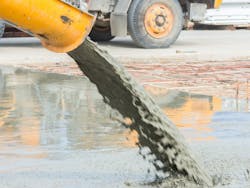Recycling Post-Demolition
By Kristin Dispenza, Contributing Author
Over the past decade, Departments of Transportation (DOT) and other agencies have received increasing demands to consider more sustainable construction for their infrastructure.
One solution: recycling post-demolition materials by crushing and processing them for use as a substitute for virgin aggregate.
Using recycled concrete as a pavement base has become an established process. More recently, paving industry companies have incorporated recycled material as a coarse aggregate replacement in ready mixed concrete. This development comes on the heels of the successful development of general-purpose mixes containing recycled aggregate.
As early as 2002, the Federal Highway Administration (FHWA) created a national policy on recycling. The crux of FHWA’s policy was that "the same materials used to build the original highway system can be reused to repair, reconstruct, and maintain [it]. Where appropriate, recycling of aggregates and other highway construction materials makes sound economic, environmental, and engineering sense.”
Since then, the FHWA has continued to emphasize recycling technology in its strategic plan, supporting research projects, technology transfer, demonstration projects, training, and more. Realizing that recycled materials are an attractive pathway, some DOTs have set ambitious targets for the use of recycled materials in their road networks.
However, for states to meet their targets, construction aggregate and recycled concrete materials must be readily available and cost-effective.
Gaps in the market can cause agencies to fall short of their ambitions to use recycled materials. Because of this, heavy building materials manufacturers, who have expertise in the supply of raw materials for roadbuilding, want to close the loop on concrete recycling and ensure that post-demolition materials find their way into new applications.
Washington offers a snapshots of how greater adoption of recycled concrete materials is commencing.
In 2016, Washington passed legislation encouraging the use of recycled concrete aggregate (RCA) in the state’s roadways. Then the Washington Department of Transportation (WSDOT) established goals for the use of RCA in its “Standard Specifications for Road, Bridge, and Municipal Construction.” Seattle also amended its specifications.
Seattle now allows up to 30% replacement of coarse aggregate using RCA in concrete paving, and WSDOT’s recently increased the allowable RCA for use to 100%.
The performance of recycled aggregate must meet the same standards as virgin aggregate. DOT personnel must work with partners in the supply chain who are able to ensure quality control on the front end of projects to meet performance metrics.
“We see concrete rubble as a valuable resource that should not be wasted in landfills,” said Steve Read, civil engineer supervisor at Seattle Public Utilities. “The reuse of concrete rubble as a replacement for construction aggregates, or as coarse aggregate in new concrete, is a central strategy in preserving our local native aggregate resources. The use of RCA is not without concerns, especially regarding pH issues. However, with intelligent and considered application, RCA is a viable and valuable resource.”
- Sustainability efforts can be expanded beyond the reuse of internally sourced concrete. Because bridges and buildings are a source of high-strength concrete, companies can support the production of RCA for concrete and meet the coarse aggregate performance requirements for reuse in concrete.
Several sites in the Seattle area are due for demolition, and demolition materials resulting from five upcoming projects will be reused as RCA in concrete mixtures. Structures that will contribute demolition materials for recycling include:
- The remaining portion of the May Creek Bridge in Renton, which is part of the Interstate-405 widening project; 1800 tons of concrete bridge demolition material will be turned into RCA for fresh concrete.
- The Lake Washington Boulevard overpass, part of a Seattle renovation project that will contribute 1300 tons of post-demolition material.
- The Lind Avenue Bridge on I-405, which is being partially replaced due to vehicle accident damage and will contribute 1000 tons of post-demolition material.
- The Northeast 85th Street interchange in Kirkland. The phase one demolition of collector lanes will contribute 3000 tons of post-demolition material and Phase two (located on the I-405 mainline, to be conducted in 2025) will contribute 6000 tons.
- An unused ramp in Seattle’s Washington Park Arboretum, scheduled for demolition in early 2024, will yield 7500 tons of post-demolition material.
As with any material used, RCA must be approved by the DOT’s Office of Materials and Testing.
Carbon accounting can be influenced by recycling concrete, sometimes in ancillary ways. For example, incorporating recycled products into concrete projects can reduce truck miles traveled, subsequently reducing fuel use and carbon dioxide emissions associated with materials sourcing.
This is because sales yards for recycled materials are usually located much closer to urban centers than quarries producing raw materials.
Travel distance can also be reduced—and fuel savings achieved—at a project's end-of-life, since recycling locations tend to be easier to access than landfills when it comes to disposing of clean construction or demolition debris (CCDD).
When landfills receive CCDD, heavy building materials manufacturers step in to retrieve some of those materials, ensuring usable concrete and asphalt rubble are recycled.
As states adopt sustainability measures, incentives are being put in place to increase the use of RCA. Expediting efficient recycling practices is a team effort that includes all members from across the value chain to make it work. RB
Kristin Dispenza is an account manager at Advancing Organizational Excellence.
